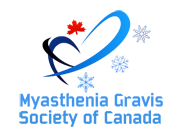Myasthenia Gravis Treatments
Which of these treatments should be used for a person with MG depends upon the severity of the weakness, which muscles are affected, the person’s age and other associated medical problems. The doctor will determine which of these treatments may be best for each patient.
There have been major advances in the treatment of MG in recent years. Although there is no cure for MG yet, the available treatments are sufficiently effective that most patients will experience considerable improvement and can eventually lead near normal lives. The various forms of treatment include medications, plasmapheresis (plasma exchange), IVIg and thymectomy.
Medications
Medications are most frequently used in treatment. Anticholinesterase agents (such as Mestinon®) allow the acetylcholine to remain at the neuromuscular junction a little longer than usual so that more receptor sites can be activated. Prednisone, a cortisone-like drug, and/or azathioprine (Imuran®) may be used to suppress the immune system and its production of all antibodies. Other immunosuppressant drugs used in MG include mycophenolate (e.g. CellCept®), cyclosporine, tacrolimus, methotrexate or cyclophosphamide. Close contact with the family doctor is desirable because these drugs may decrease the body’s natural protection against infection. Some medications (azathioprine in particular) require regular monitoring of blood tests such as liver tests and monitoring of white blood cell counts.
IVIG - Intravenous Immunoglobulin
IVIG is most commonly used for patients with an exacerbation of their MG. Its effectiveness has been demonstrated in randomized clinical trials. It is used under similar circumstances to plasmapheresis.
Thymectomy
Thymectomy (the surgical removal of the thymus gland) is sometimes used in MG. The thymus lies behind the breastbone and is an important part of the immune system. Younger patients with MG may have a “hyperplastic‟ thymus whereas in older patients there is a chance of a tumour in this gland (in 10 -15% of patients) called a thymoma. If there is a thymoma, the thymus is usually removed to reduce the risk of malignancy but usually does not help the MG. When the thymus is hyperplastic, a thymectomy may reduce the severity of muscle weakness which usually takes months after surgery. In a few patients the muscle weakness may completely disappear and this is called a remission. How mch a thymectomy helps varies with each patient but it is most effective when AChR antibodies are positive.
Laboratory Tests
Plasmapheresis may also be useful in the treatment of MG. This procedure removes the abnormal antibodies from the serum of the blood in patients with MG. The improvement in muscle strength may be striking but is usually short-lived (weeks to 1-2 months) since the abnormal antibodies continue to be formed. Therefore, when plasmapheresis is used, it may require repeated use. Plasmapheresis may be especially helpful during a period of MG crisis or before surgery including a thymectomy.
Information in the Myasthenia Gravis Society of Canada Website express the views of the author and are for information only, not medical advice. Patients should consult with their physicians for medical treatment.
